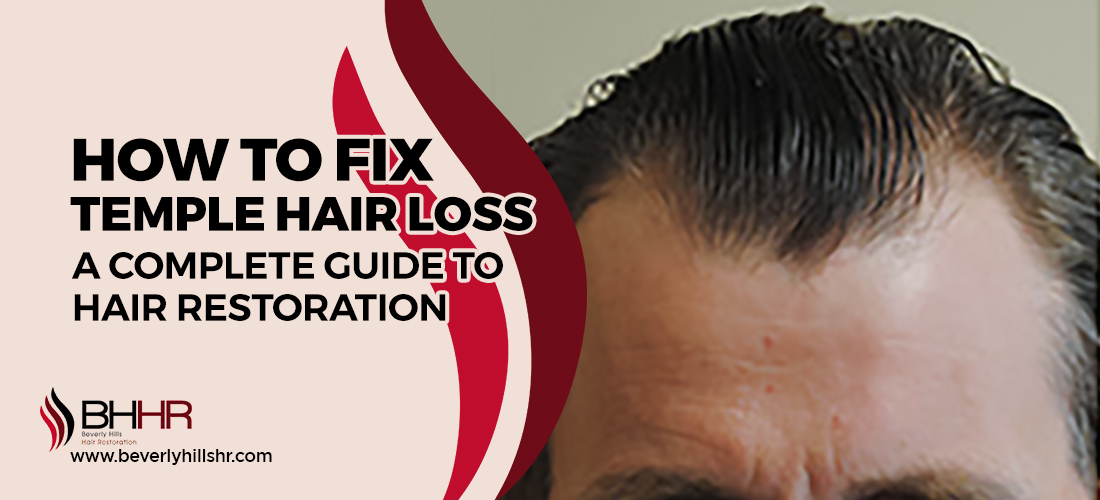How to Fix Temple Hair Loss: A Complete Guide to Hair Restoration
Home / Hairline Hair Transplant / How to Fix Temple Hair Loss: A Complete Guide to Hair Restoration
Posted on : February 21, 2025 | Category : Hairline Hair Transplant | Author: Beverly Hills Hair Restoration Team

Temple hair loss significantly impacts the balance and shape of the face. As the hair around the temples begins to recede or thin, it can create a less youthful or uneven look, affecting the overall appearance. The temples are important in defining facial features, and when hair loss occurs here, it can make the face appear older or imbalanced.
One of the effective solutions is a temple hair transplant. This procedure involves transferring healthy hair follicles to the temple area, restoring the fullness and natural contour of the hairline. Filling in the receded temple areas helps to enhance facial symmetry and bring balance to your face. Restoring temple hair improves your appearance and boosts your confidence, giving you a refreshed and rejuvenated look. Our hair transplant clinic in Los Angeles specializes in temple hair transplants, offering personalized treatments for natural-looking results.
Temple Hair Loss: Why It Happens and Why It Matters
Temple hair loss is a common concern for many individuals, and it's easy to see why—it significantly impacts the balance and symmetry of your face. Understanding why this occurs is the first step toward restoring the fullness and natural contour of the temple area. Whether it's caused by genetics, hormonal changes, or other factors, knowing the root causes can help you take action and prevent further loss.
Differences Between Female and Male Pattern Baldness:
- Male-Pattern Baldness: Men typically experience temple hair loss as part of male-pattern baldness, where the hairline recedes in a distinct pattern, often progressing to a more prominent bald spot or thinning crown.
- Diffuse Hair Loss in Women: For women, temple thinning is often a sign of diffuse hair loss, where hair thins across the entire scalp rather than following the receding pattern seen in men.
By recognizing the causes of temple hair loss and how they impact men and women differently, you can better decide on the best treatment options, such as a temple hair transplant, to restore your youthful appearance.
Techniques Used in Temple Hair Transplant Surgery
Two primary techniques are used in temple hair transplant surgery: Smart FUE and Smart FUT. Both methods are designed to restore hair in the temple area, but each has its unique process, benefits, and drawbacks.
-
Smart FUE (Follicular Unit Extraction):
Smart FUE hair transplant involves extracting individual hair from the donor site with a small punch tool and implanting them into tiny incisions in the temple area. This method leaves minimal scarring, offers faster recovery, and is ideal for smaller, precise areas where natural angles and detailed results are needed.
-
Smart FUT (Follicular Unit Transplantation):
Smart FUT Hair transplant removes a strip of skin with hairs from the donor area, which is then divided into follicular units and transplanted into the temple area. This method provides a higher graft yield, making it suitable for larger areas of hair loss, but leaves a scar at the donor site, which can be visible with short haircuts.
Note: We enhance FUE and FUT using Smart PRP methods for superior results. Injecting Plasma into the scalp before implantation boosts healing, strengthens grafts, and accelerates hair growth. This innovative approach enhances both methods, making them "Smart FUE" and "Smart FUT.”
How Does Temple Hair Transplant Work at BHHR
At Beverly Hills Hair Restoration in Los Angeles, we ensure a smooth and comfortable hair transplant experience by carefully guiding you through each step of the process.
Before the Surgery: Your journey starts with a free consultation; during this, our hair transplant doctor evaluates the donor area and designs a hairline that complements your features; he also provides pre-surgery instructions, including avoiding smoking, alcohol, and certain medications to prepare your body for the procedure.
During the Procedure: Local anesthesia is administered to ensure a pain-free experience. The first step involves extracting hair follicles from the donor area using Smart FUE or Smart FUT, depending on your needs. Next, the grafts are carefully prepared for implantation. Finally, the grafts are strategically placed at the temples, focusing on creating natural angles and spacing to enhance facial symmetry and ensure a youthful, natural appearance.
Post-Surgery: After the procedure, bandaging is applied, and we provide immediate care instructions. Familiar post-surgery sensations include mild swelling, redness, and itching in the treated areas, which are temporary and part of the healing process.
Common Mistakes to Avoid After a Temple Hair Transplant
Proper aftercare is essential for a successful temple hair transplant. Inevitable mistakes can hinder healing and affect the final results. To ensure the best outcome, avoid these common post-transplant errors:
- Scratching the recipient area – Can dislodge grafts and slow healing.
- Exposing the scalp to sunlight too soon – UV rays can damage delicate follicles.
- Using harsh shampoos or hair products – Chemicals may irritate and weaken new grafts.
- Wearing tight hats or helmets – Can put pressure on the scalp and disrupt healing.
- Ignoring prescribed medications – Increases the risk of infection and inflammation.
- Exercising too soon – Sweat and strain can delay healing.
- Sleeping in the wrong position – Keeping the head elevated reduces swelling.
- Washing hair too early – Wait for the recommended time to protect grafts.
Who Is a Candidate for a Temple Hair Transplant?
A temple hair transplant is ideal for individuals experiencing hairline recession or thinning around the temples. Not everyone is a suitable candidate, so certain factors determine eligibility for the procedure.
- Healthy individuals with stable hair loss patterns – The best candidates are those whose hair loss has stabilized, ensuring that further thinning won’t impact transplant results.
- Sufficient donor hair availability – Successful transplantation depends on having enough healthy hair follicles in the donor area, usually at the back or sides of the head.
- Realistic expectations – Understanding that a transplant improves hair density but won’t recreate the original hair volume is crucial for satisfaction with the final results.
Conclusion: Is Temple Hair Transplant Right for You?
If temple hair loss affects your confidence, a temple or hairline hair transplant at Beverly Hills Hair Restoration might be the right solution. Modern techniques have made hair restoration more precise, natural-looking, and effective. This procedure is ideal for those seeking a permanent solution to receding temples, helping to restore facial balance and improve overall appearance. However, it is essential to consult with Dr John Kahen to determine if you are a good candidate based on your hair loss pattern and donor hair availability. Realistic expectations are also important, as results vary for each person. With advanced procedures like Smart FUE and Smart FUT, patients can achieve fuller, natural-looking hairlines with minimal downtime with advanced procedures like FUE. If temple hair loss concerns you, exploring surgical options in Los Angeles, our clinic could be the first step toward renewed confidence.
Struggling with temple hair loss? Get expert solutions with a Free consultation for temple hair restoration. Take the first step toward a fuller, natural look—call us now at 310.289.0901 to begin your journey today!
